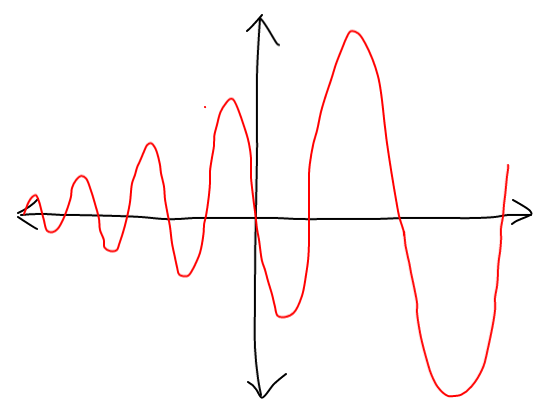To Infinity... and Beyond!... with Waves
Can anyone give an equation of the function such that
- the range of the graph is ?
- the graph of looks like a sine wave graph?
- the period of the graph is 4?
- the graph increases in amplitude (by an arithmetic progression constant or a geometric progression constant) as ?
- the amplitude approaches as , but there is no value of x on the graph at which the amplitude equals ?
- either the graph passes through the point (0,0), or...
- the x-intercept of the highest point of a crest of the graph or of the lowest point of a trough of the graph at is (if a crest is at ) or (if a trough is at )?
- the equation/graph has no transformations? (As much as possible, the equation doesn't have any unnecessary variable or number.)
- the equation contains the most "possible" amount of basic mathematical elements? (There are more basic mathematical elements than advanced ones, e.g., there are more mathematical elements related to quotients than those related to logarithms.)

The picture above is merely for you to conceptualize what the graph looks like; the graph that is shown is not exactly the one I'm looking for.
No vote yet
1 vote
Easy Math Editor
This discussion board is a place to discuss our Daily Challenges and the math and science related to those challenges. Explanations are more than just a solution — they should explain the steps and thinking strategies that you used to obtain the solution. Comments should further the discussion of math and science.
When posting on Brilliant:
*italics*or_italics_**bold**or__bold__paragraph 1
paragraph 2
[example link](https://brilliant.org)> This is a quote# I indented these lines # 4 spaces, and now they show # up as a code block. print "hello world"\(...\)or\[...\]to ensure proper formatting.2 \times 32^{34}a_{i-1}\frac{2}{3}\sqrt{2}\sum_{i=1}^3\sin \theta\boxed{123}Comments
Let f:R→R be a function with period 4 such that the following holds : x→−∞limf(x)=0
Pick x∈[0,4) and k∈N. Then, 0=k→∞limf(x−4k)=k→∞limf(x)=f(x)
Hence, f(x)=0∀x∈[0,4)⟹f(x)=0∀x∈R
Evidently this function doesn't satisfy the other criteria.
We conclude that such a function doesn't exist. :P
P.S.: Based on the graph shown, I guess you had something like the following function in mind : f(x)=exsin(2πx)
Log in to reply
I'm sorry, but could you illustrate your proof in words? I'm bad at understanding math notations...
Log in to reply
Fix some value of x such that 0≤x<4.
Now go 4 units back k times, i.e., consider x−4k. Notice that this doesn't change the value of f at this point, i.e, f(x−4k)=f(x), due to periodicity of f.
When k is very large, we, in a sense, reach −∞. Hence, as the value of f here is zero (intuitively), we conclude that the value of f with which we began is also zero, i.e., f(x)=0 where 0≤x<4.
Again, the periodicity of f shows that this is the case everywhere, i.e., f(x)=0 for all x.
Hey,
I agree with him. I had this in class on highschool and we came to the same solution.